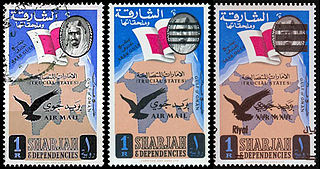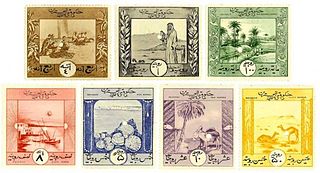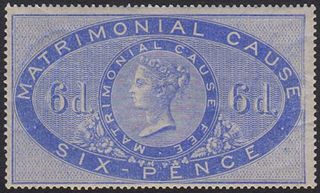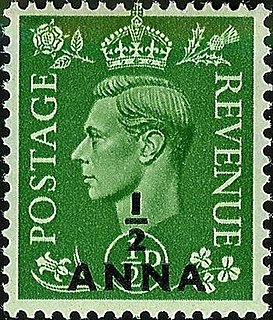
The United Arab Emirates , formerly known as Trucial States , first issued revenue stamps in 1948 and continues to do so to this day. In addition, the emirates of Abu Dhabi and Dubai also had their own separate revenue issues.

The United Arab Emirates , formerly known as Trucial States , first issued revenue stamps in 1948 and continues to do so to this day. In addition, the emirates of Abu Dhabi and Dubai also had their own separate revenue issues.
Prior to independence, the UAE was known as the Trucial States. Until 1947 they were administered as a part of British India, and they used Indian revenues. However, following India's independence they were administered by Britain, using Indian currency. The first revenue issue was in 1948, and it consisted of British King George V or King George VI keytypes appropriated COURT FEE and the value in annas or rupees at the bottom. Similar issues with values in naye paise or later paise were printed using keytypes of King George VI and Queen Elizabeth II. However, there are no recorded examples of these, and only values from the first issue are known to exist. [1] [2]
After independence in 1971, the Trucial States became known as the United Arab Emirates. The first revenues were issued in around 1973 and they showed a dhow, a palm tree, an oil rig and camels, and a map and symbols of the newly independent country. In 1975 a new design portraying the coat of arms was issued, and all later stamps were in this design. From 1988 onwards, stamps in this design but a different inscription below the coat of arms were also issued to pay the medical fee as well. [1] [3]
The emirate of Abu Dhabi issued revenues from around 1970 to 1990. The first consisted of an overprint on the contemporary 1 dinar postage stamp in use then, and this was followed by a set of three values portraying the country's coat of arms in around 1985. The highest value of this set was reissued in new colours with some differences in design in 1990. All of Abu Dhabi's revenue stamps are scarce or rare and are highly sought after by collectors. [1] [4]
The emirate of Dubai issued a single revenue stamp by the Central Immigration Department. The stamp is recorded used from 1972 to 1973. [5]

Civil mail from Sharjah went through the post office in Dubai until 1963. Military mail from the British Forces stationed in the area went through the RAF airport in Sharjah.

Now part of the United Arab Emirates, Abu Dhabi was formerly the largest of the seven sheikdoms which made up the Trucial States on the Pirate Coast of eastern Arabia between Oman and Qatar. The Trucial States as a whole had an area of some 32,000 square miles of which Abu Dhabi alone had 26,000. The capital was the town of Abu Dhabi which is on an offshore island and was first settled in 1761.

This is a survey of the postage stamps and postal history of the United Arab Emirates (UAE).

The first revenue stamps of Bahrain were issued in 1924. Before then Indian revenue stamps were used on documents. Revenue stamps have been used for Land Registry documents, drivers permits and the Dhow Registry.

Revenue stamps of Malta were first issued in 1899, when the islands were a British colony. From that year to 1912, all revenue issues were postage stamps overprinted accordingly, that was either done locally or by De La Rue in London. Postage stamps also became valid for fiscal use in 1913, so no new revenues were issued until 1926–30, when a series of key type stamps depicting King George V were issued. These exist unappropriated for use as general-duty revenues, or with additional inscriptions indicating a specific use; Applications, Contracts, Registers or Stocks & Shares. The only other revenues after this series were £1 stamps depicting George VI and Elizabeth II. Postage stamps remained valid for fiscal use until at least the 1980s.

Revenue stamps of the United Kingdom refer to the various revenue or fiscal stamps, whether adhesive, directly embossed or otherwise, which were issued by and used in the Kingdom of England, the Kingdom of Great Britain, the United Kingdom of Great Britain and Ireland and the United Kingdom of Great Britain and Northern Ireland, from the late 17th century to the present day.

The island of Antigua issued revenue stamps from 1870 to 1876. The island's short life as a revenue stamp-issuing country was mainly due to the use of postage stamps for most fiscal purposes from 1862 to 1870, and again from 1890 onwards. Therefore, the only revenues issued are more commonly found mint than used. The first set was issued in 1870 and it consisted of eleven values from 1d to 10s, and four of these values were reprinted in 1876 with a different watermark. This makes a total of just fifteen revenues, with most sought after one being the 10s stamp of 1870.

The island of Cyprus first issued revenue stamps in 1878 and continues to do so to this day. The Turkish Republic of Northern Cyprus also issues its own revenue stamps.

The British colony of Bermuda issued revenue stamps from 1936 to 1984.

Eritrea first issued revenue stamps under the Italian Eritrea administration. It continued to issue revenues under British and Ethiopian occupation, as well as when it became an independent state. The capital Asmara also issued some revenues.

British postal agencies in Eastern Arabia issued early postage stamps used in each of Abu Dhabi, Bahrain, Dubai, Kuwait, Muscat and Qatar. Muscat and Dubai relied on Indian postal administration until 1 April 1948 when, following the Partition of India, British agencies were established there. Two agencies were opened in Qatar: at Doha and Umm Said. In Abu Dhabi, an agency was opened on Das Island in December 1960 and in Abu Dhabi City on 30 March 1963. The agencies also supplied stamps to Bahrain until 1960; and to Kuwait during shortages in 1951–53.

Libya first issued revenue stamps when it was an Italian colony in 1913 and continues to do so to this day. The provinces of Cyrenaica, Tripolitania and Fezzan as well as the municipality of Tripoli also had separate revenue issues until the 1950s and 1960s.

Revenue stamps of Jamaica were first issued in 1855. There were various types of fiscal stamps for different taxes.

Malaysia first issued revenue stamps as the Straits Settlements in 1863, and continues to do so to this day. Over the years, a number of entities in modern Malaysia have issued revenue stamps.

Over the years various Malay States issued their own revenue stamps. Now most states use Malaysian revenue stamps, except for Singapore which is independent and no longer uses revenue stamps.
Revenue stamps of Seychelles were first issued in 1893, when the islands were a dependency of the British Crown Colony of Mauritius. The first stamps were Mauritius Internal Revenue stamps depicting Queen Victoria overprinted for use in Seychelles, and Bill stamps were also similarly overprinted. Postage stamps depicting Victoria or Edward VII were overprinted for fiscal use at various points between 1894 and 1904, while surcharges on Bill stamps were made in around 1897–98.
Revenue stamps of Montserrat were first issued in 1866, ten years before the island issued its first postage stamps. The island only issued two different designs of revenue stamps, but postage stamps were widely used for fiscal purposes and are still used as such today.
Dunes in philately refers to the many editions of stamps produced in the Trucial States. The stamps, printed in great profusion in the 1960s, are mostly near-worthless today.

A postage and revenue stamp, sometimes also called a dual-purpose stamp, is a stamp which is equally valid for use as a postage stamp and as a revenue stamp. They often but not always bear an inscription such as "Postage and Revenue". Dual-purpose stamps were common in the United Kingdom and the British Empire during the 19th and 20th centuries, and they are still used in some countries as of the early 21st century.
Revenue stamps of Guyana refer to the various revenue or fiscal stamps, whether adhesive, directly embossed or otherwise, which have been issued by Guyana since its independence in 1966. Prior to independence, the country was known as British Guiana, and it had issued its own revenue stamps since the 19th century. Guyana used dual-purpose postage and revenue stamps until 1977, and it issued revenue-only stamps between 1975 and the 2000s. The country has also issued National Insurance stamps, labels for airport departure tax and excise stamps for cigarettes and alcohol.